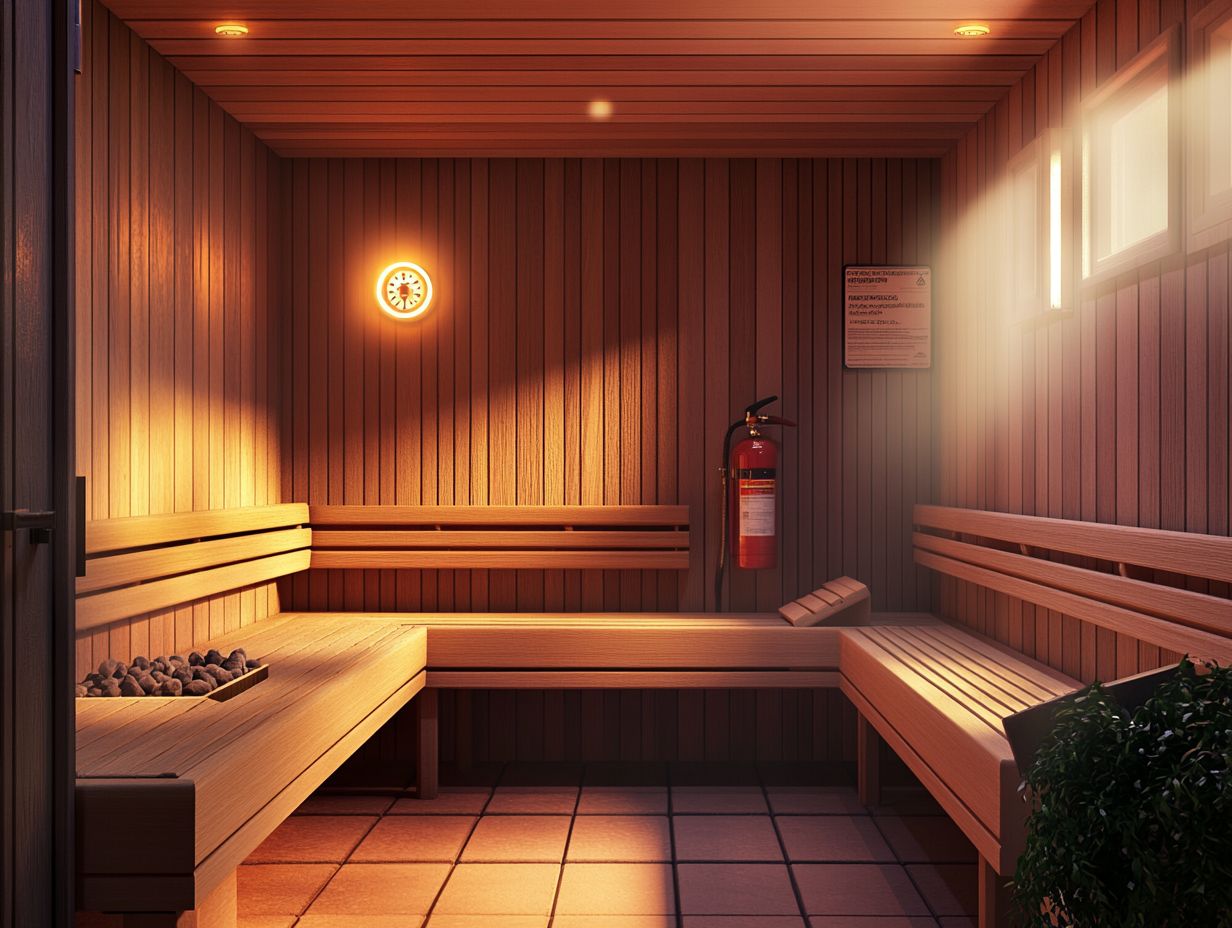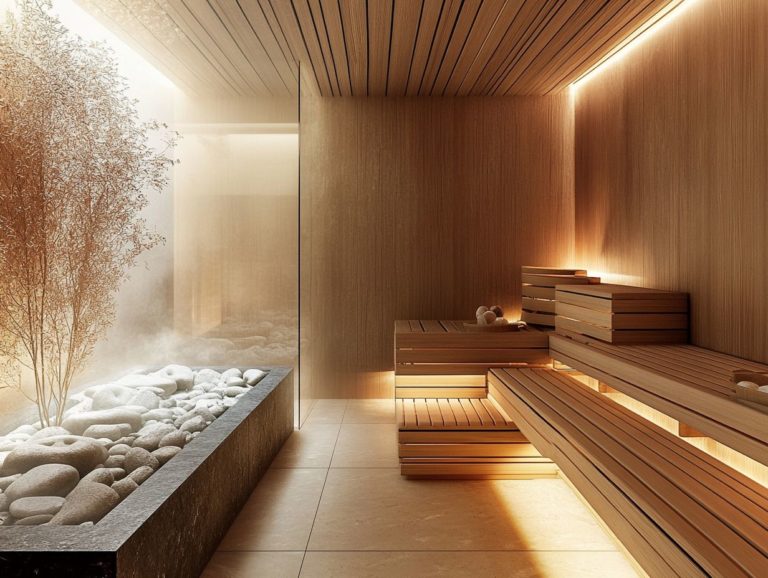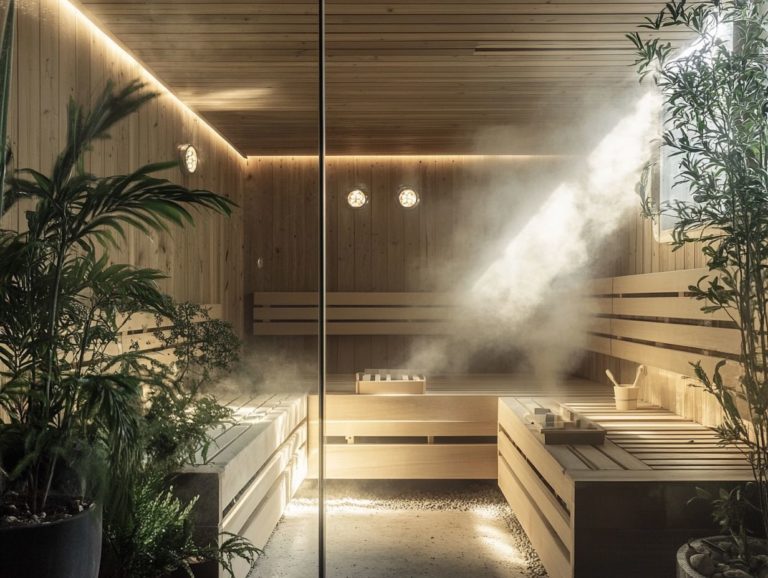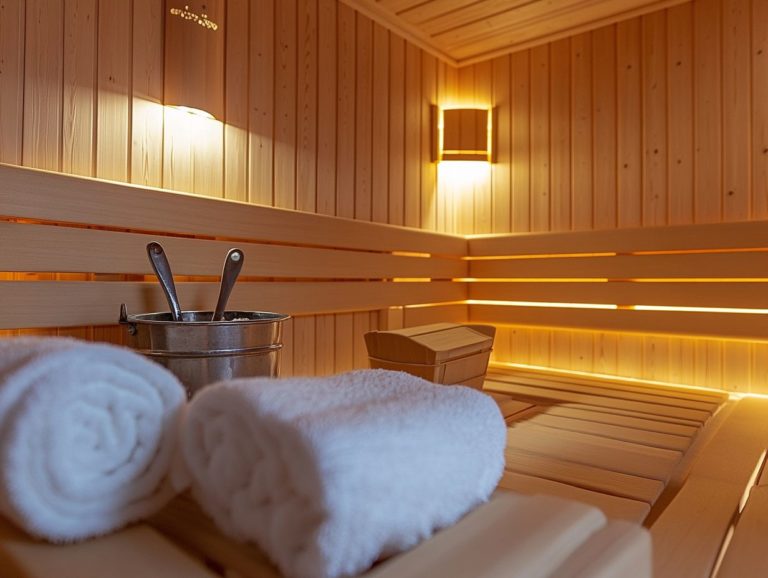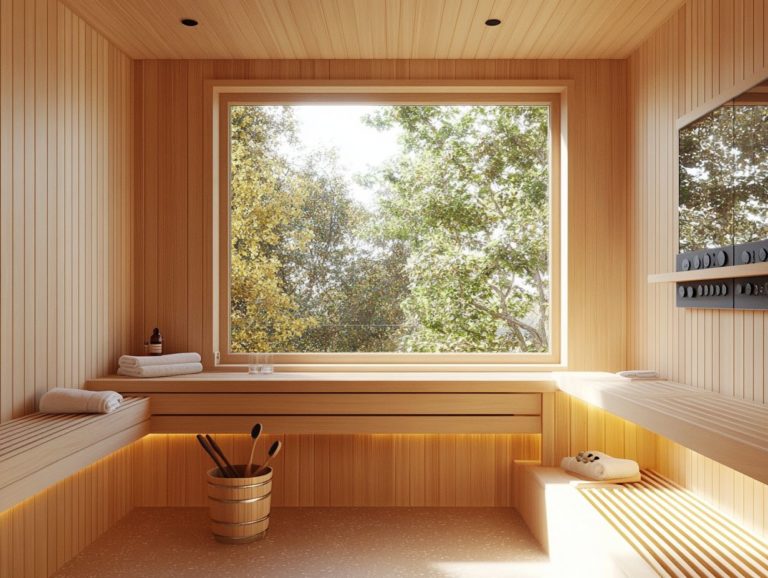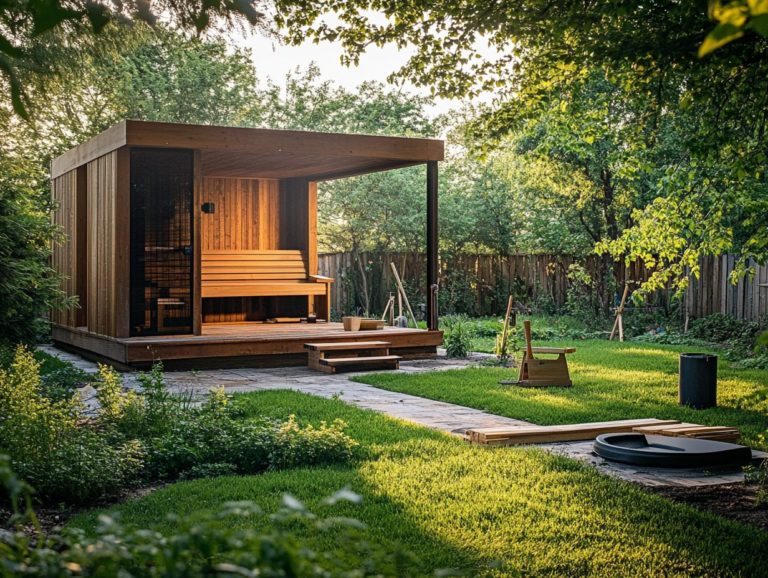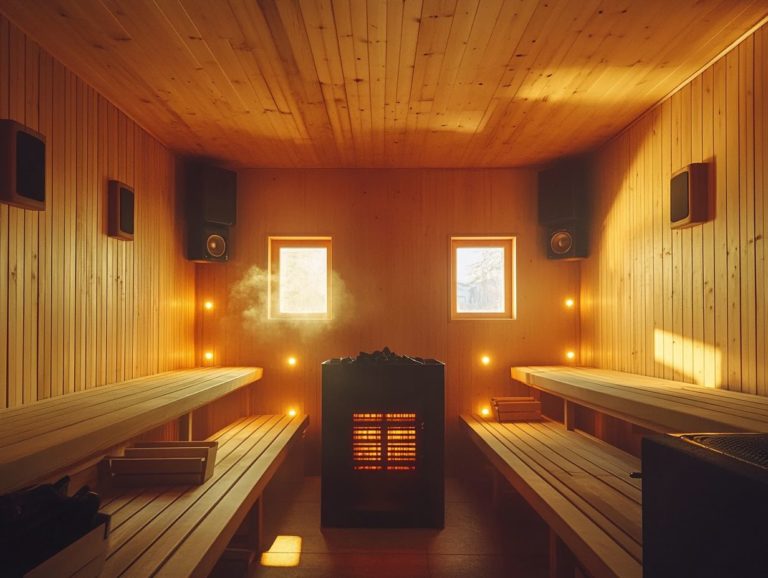“DIY Sauna Safety: Best Practices to Follow”
Are you contemplating the soothing and health-enhancing experience of a DIY sauna, including options like an outdoor sauna or infrared sauna?
This guide is your complete resource for creating the perfect sauna! You ll find everything from grasping the concept of a DIY sauna to uncovering its many benefits for both your body and mind.
A personal sauna is appealing, but you must consider the risks associated with sauna construction and the right steps to build a safe sauna.
Within this guide, you ll find a comprehensive step-by-step approach for building your sauna, along with usage tips and vital safety measures to ensure your experience is both enjoyable and secure.
Jump into the exciting world of DIY saunas, where you can explore different sauna types!
Contents
Key Takeaways:
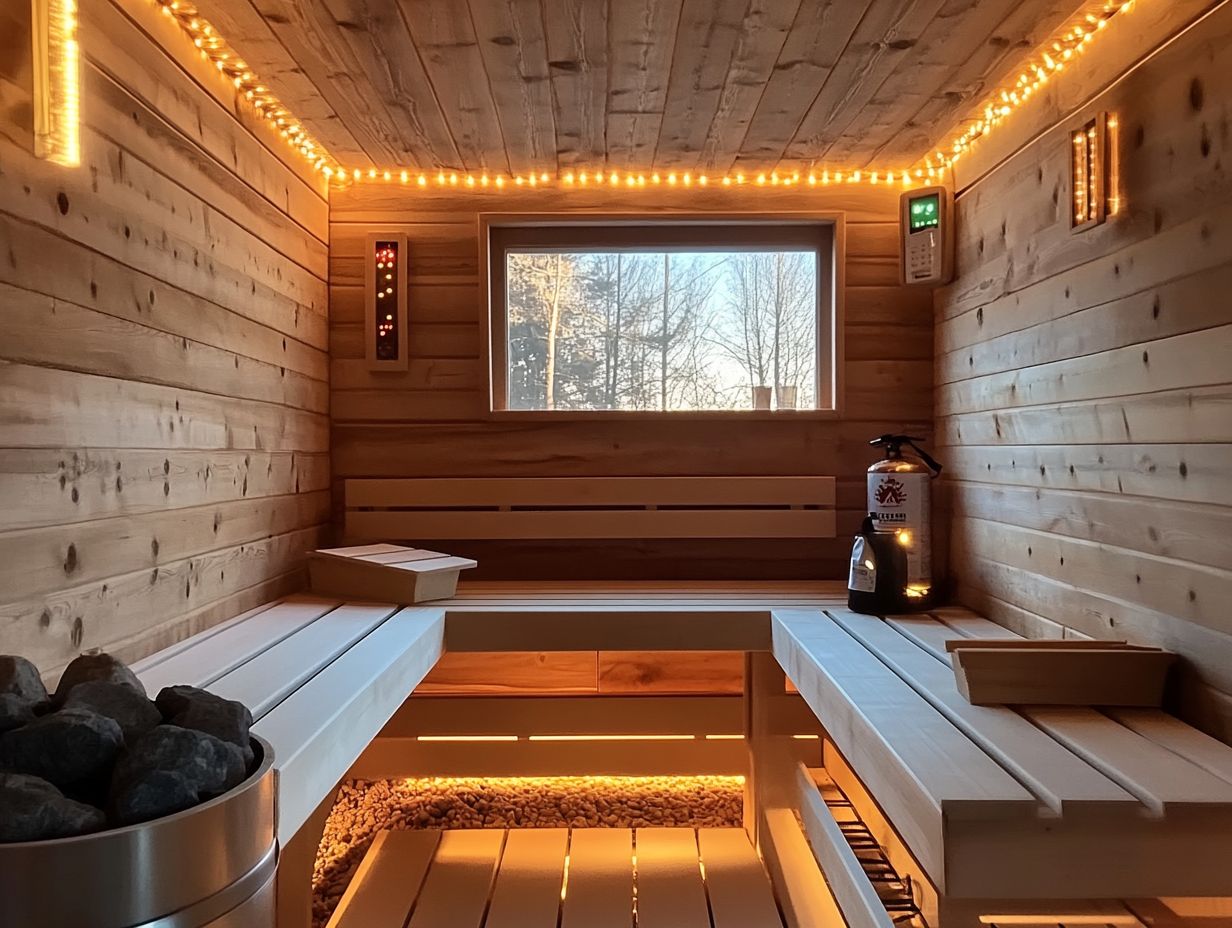
- Building a DIY sauna has many benefits for your health but comes with safety risks.
- Proper preparation and maintenance are crucial for a safe sauna experience.
- Follow best practices like using the right materials and ensuring good ventilation.
Understanding DIY Saunas
DIY saunas are gaining traction among wellness enthusiasts who appreciate a tailored approach to relaxation and health.
With choices like outdoor saunas, electric saunas, and infrared saunas, you have the opportunity to design a sauna experience that perfectly aligns with your lifestyle and preferences.
It’s crucial to understand the different types of DIY saunas, whether they’re crafted from aromatic cedar wood, the distinct beetle kill pine, or other suitable materials. This knowledge enables you to make informed decisions about your sauna construction.
These saunas not only offer significant physical and mental benefits but also create a unique setting for social occasions with friends and family.
What is a DIY Sauna?
A DIY sauna is your chance to create a personal retreat, allowing you to customize everything from the design to the sauna materials think luxurious cedar wood or other options that fit your vision.
This hands-on approach results in a sauna that reflects your unique style and opens up a world of creative possibilities.
You might explore designs, from traditional Finnish aesthetics to sleek, modern minimalist setups.
Regarding materials, you ll typically use heat-resistant wood, insulation, and optional accessories like benches and heaters, all of which work together to cultivate a cozy atmosphere.
The construction process involves thoughtful planning and gathering the right resources, ensuring that every detail from size to layout aligns perfectly with your individual needs and available space.
In the end, building your own sauna can be a rewarding experience, blending functionality with your personal touch and ensuring sauna hygiene.
Benefits of DIY Saunas
DIY saunas present a wealth of advantages that significantly elevate both physical and mental wellness, making them an appealing choice for those dedicated to their health.
Standout benefits include improved circulation, detoxification through sweating, and deep relaxation, providing an excellent health experience.
By committing to regular sauna sessions, you can enjoy stress relief, enhanced hydration, and a remarkable boost in your overall well-being all contributing to a truly enriching sauna experience.
You can customize your sauna to fit your needs, maximizing the benefits and ensuring that your journey toward wellness is uniquely yours.
Ready to create your DIY sauna? Let’s get started!
Physical and Mental Health Benefits
The physical and mental health benefits of saunas are remarkable. They offer improved circulation, detoxification through sweating, and profound relaxation during each session.
By using saunas regularly, you enhance your heart health. This helps your blood flow better and lowers blood pressure. The increased sweating is great for your skin, helping to clear pores and reveal a radiant complexion.
Feel the warmth wrap around you like a comforting hug! It alleviates muscle tension and invites a deep sense of comfort.
On the mental health side, incorporating sauna sessions into your routine can significantly reduce stress. It provides a welcome escape from daily worries and uplifts your mood. You will experience a lasting sense of well-being that lingers long after you step out of the heat.
Risks of DIY Saunas
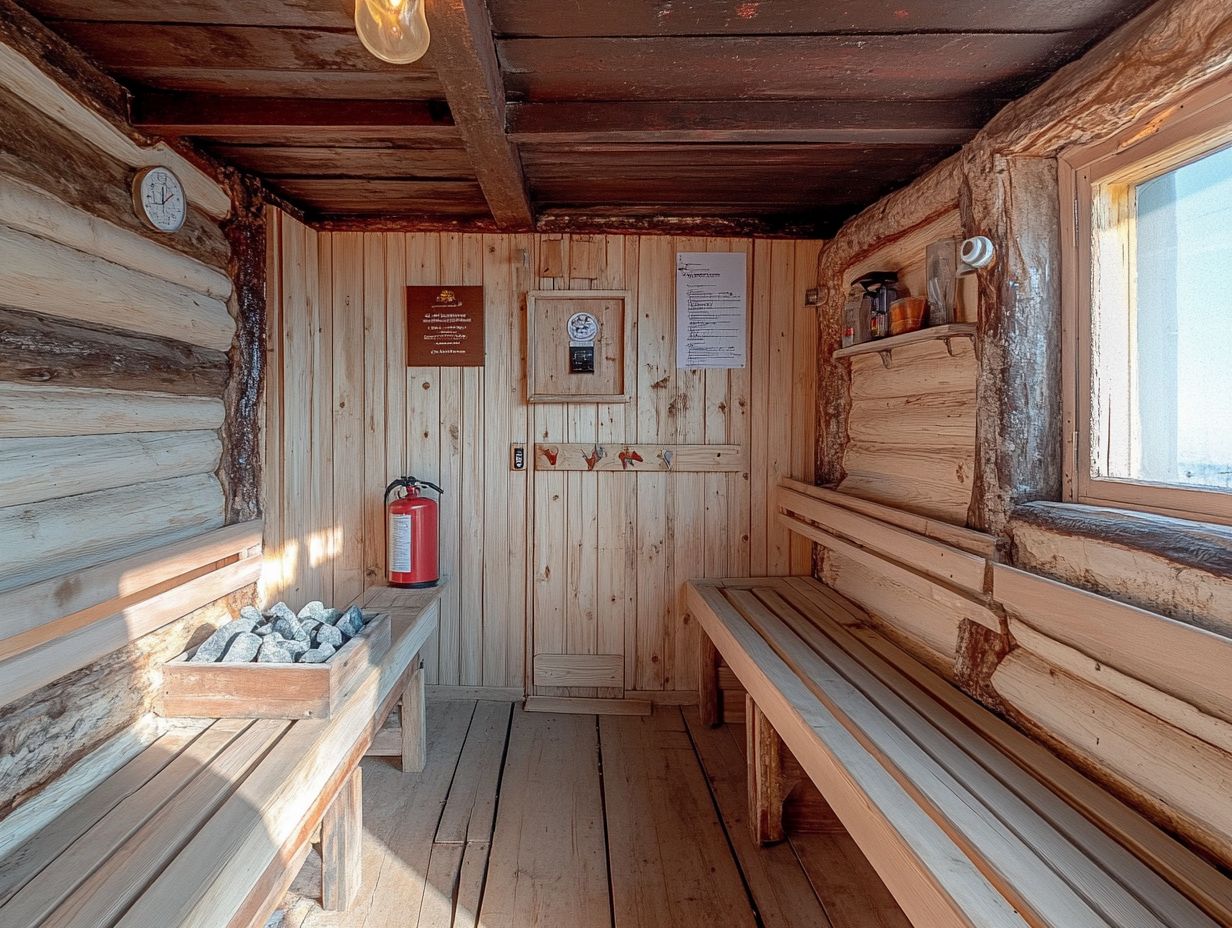
While DIY saunas offer many benefits, it s crucial to recognize potential risks, especially related to safety hazards from sauna design and maintenance. Understanding the principles of sauna safety is vital for an enjoyable and secure experience.
Common issues include improper ventilation, excessive temperatures, and inadequate materials. These can lead to discomfort or health concerns if not managed properly. Adopting sauna safety tips is essential for protecting your sauna experience.
Potential Safety Hazards
In your DIY sauna, improper temperature settings, subpar materials, and insufficient maintenance practices can create safety hazards.
Fire risks are a significant concern, especially if sauna heaters are not installed or maintained correctly. Overheating can cause severe discomfort or even health issues if you ignore recommended temperature guidelines. To ensure safety, it’s important to follow sauna safety best practices. Ventilation problems can worsen these dangers, leading to poor air quality and harmful gas buildup.
To mitigate these risks, conduct regular inspections of heating elements. Ensure the materials you use are fire-resistant. Following proper usage protocols, such as allowing the sauna to cool between sessions and maintaining good airflow, can enhance safety and improve your experience. Additionally, consider community sauna safety programs for further benefits.
Preparing for a DIY Sauna
Preparing for a DIY sauna requires thoughtful planning. Start with selecting materials and design features that fit your unique space. Choose high-quality wood, such as cedar or beetle kill pine, and ensure proper ventilation. This meticulous preparation sets the stage for success.
Understanding the layout and dimensions of your sauna area is key to creating a comfortable and functional experience. By considering these factors and adhering to guidelines outlined in sauna safety: the role of responsible ownership, you’ll craft a sauna that meets safety standards and boosts your overall well-being.
Important Considerations and Precautions
When building a DIY sauna, keep important considerations and precautions in mind. Prioritize proper sauna hygiene, optimal ventilation, and follow established safety tips for construction and use.
Selecting the right materials is essential for durability and comfort. Think about options like cedar or hemlock, which naturally resist moisture and withstand heat. Don t overlook the layout design it with easy-to-clean surfaces and access points to simplify sanitation practices, including regular disinfection.
Invest in a high-quality heater that meets safety standards, paired with appropriate flooring to prevent slips. By emphasizing these elements, you enhance the overall experience and create a safe and inviting space for relaxation.
Don t take chances! Understanding these risks can save you and your loved ones from serious harm. Start your DIY sauna project safely or seek expert advice today!
Building a DIY Sauna
Building a DIY sauna is a rewarding project. You can customize it to fit your style and needs.
With high-quality materials and clear design guidelines, you can create a space for relaxation and socializing.
Gather the right tools and resources, and you’ll be amazed at what you can create. Your sauna can become a reality that promotes health and tranquility.
Step-by-Step Guide
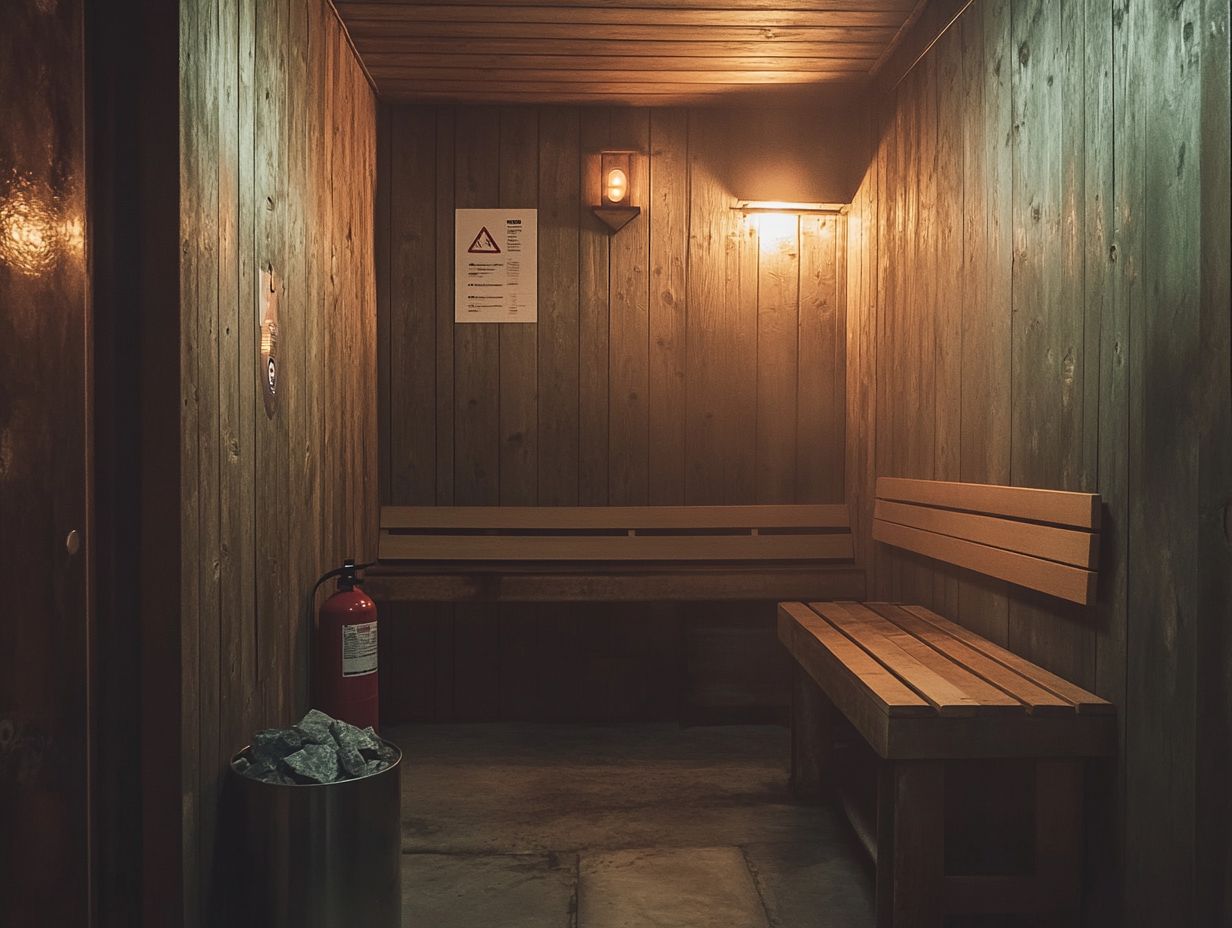
Here s a simple guide to building your DIY sauna:
- Select the perfect sauna heater.
- Choose design elements that match your style.
- Ensure top-notch insulation.
Planning your layout is key to making the most of your sauna. Evaluate the size and style, as these will influence your heater choice.
Gather high-quality materials and tools before starting. When installing the sauna heater, follow the safety rules for electricity.
After completing the main structure, focus on design choices like lighting and benches. Don t forget ventilation; it helps air flow and enhances your experience.
Using a DIY Sauna
Using a DIY sauna can greatly enhance your experience. Focus on session duration and proper hydration.
To maximize benefits, understand the ideal duration for sauna use and prepare your body for the heat.
Incorporating social gatherings into your sauna routine can lead to memorable moments with friends and family.
Proper Usage and Maintenance
Proper usage and maintenance are crucial for safety and hygiene.
Establish regular cleaning routines, especially for surfaces and benches, to prevent bacteria buildup.
Inspect the sauna heater regularly to ensure efficiency and safety, as overheating can pose serious risks.
Simple hygiene practices, like showering before entering, keep the sauna clean and minimize odors for a pleasant atmosphere.
By maintaining these routines, you ll create an inviting environment for relaxation and rejuvenation.
Safety Measures for DIY Saunas
Implementing safety measures for your DIY sauna is vital to prevent risks and ensure a secure experience.
Familiarize yourself with essential safety tips like selecting appropriate materials and maintaining the ideal sauna temperature to lower the chance of accidents.
Regular inspections and following guidelines cultivate an environment that prioritizes relaxation and enjoyment while keeping safety in mind.
Best Practices to Follow
When engaging in DIY saunas, embracing best practices is essential for your safety and enjoyment. Follow sauna safety protocols and maintain hygiene for the best experience.
Keep the temperature right, ideally between 150 F to 195 F. Hydration is crucial, so drink plenty of water before and after your sessions.
Limit your time to 15-20 minutes. This gives your body time to adjust and cool down properly.
Explore relaxation techniques like deep breathing or meditation. Building a sauna community can boost enjoyment and relaxation.
Frequently Asked Questions
1. What are the most important safety practices to follow when building a DIY sauna?
When building a DIY sauna, choose a suitable location, use proper insulation, and install smoke and carbon monoxide detectors. Always follow the manufacturer’s instructions.
2. Is it necessary to use a professional electrician for wiring the sauna?
Yes, using a licensed electrician is highly recommended. This ensures all wiring is safe and compliant with codes.
3. Are there safety concerns when using a wood-burning sauna stove?
Yes, maintain and clean your stove regularly. Use the right type of wood and ensure proper ventilation to prevent carbon monoxide buildup.
4. Can I use any type of wood for building a sauna?
No, use woods like cedar, redwood, or hemlock. These are durable and resist warping in heat and humidity.
5. What is the maximum temperature for a sauna?
The maximum recommended temperature is typically 190 F. Exceeding this can lead to heat exhaustion or burns.
6. How often should I check and maintain my sauna for safety?
Regular checks are vital, especially before each use. Inspect electrical components, ventilation, and wooden parts. A yearly professional inspection is also recommended.
Get started on your DIY sauna today for an amazing experience!

